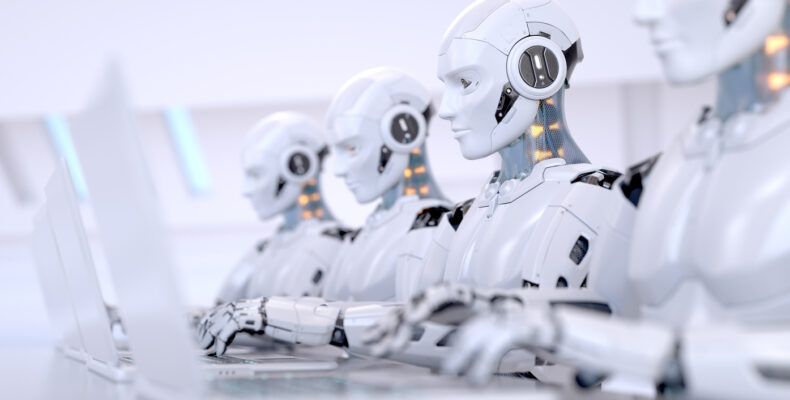
Can AI be an inventor? Thaler loses at the Court of Appeal
What may have originally seemed to be the realms of science fiction is slowly becoming reality. This creates many problems, even in the Intellectual Property (IP) community. Can Artificial Intelligence (AI) invent or create IP? Who owns it? Is it truly original?
Firstly let’s take a look at science fiction – and be warned, this paragraph contains a spoiler alert. In Douglas Adam’s ‘Hitchhikers’ Guide to the Galaxy’ series, the super computer character Deep Thought is created by a pan-dimensional, hyper-intelligent species of beings to answer the ‘Ultimate Question of Life the Universe and Everything’. After 7.5 million years of processing, Deep Thought returns the answer: “42”, before admitting that it didn’t really know what the question is. It then sets about building an even more powerful computer – The Earth – to try and determine the question. The Earth is destroyed to make way for an intergalactic highway before it can complete its task.
A somewhat obscure question is often asked upon reading the series by the people at the intersection of fans of the work of Douglas Adams and IP geeks is: who would own the work done by Deep Thought and other computers?
The original book was published in 1979 but 43 years later, in real life situations, AI technology has developed so that those questions are now being considered.
A decision from the Court of Appeal earlier this year has made the headlines even outside the IP world. The hearing related to the refusal of two patent applications by Dr Stephen Thaler. Dr Thaler is filing similar applications around the world to try and drive decisions on whether AI can be named as an inventor.
In UK patent law, there is a requirement to name any inventors of the invention described in a patent application, and to show how the applicant derived ownership of the rights from the inventor or inventors. Dr Thaler named an AI system as the only inventor and claimed ownership in the patent rights by result of his ownership of the AI system.
The application was refused by the UK IPO for failing to name an inventor and failing to show how Dr Thaler derived the rights. The High Court upheld this decision and Dr Thaler appealed.
On a split decision, the Court of Appeal upheld the previous rulings.
Whilst AI inventorship was the headline grabbing subject of this decision, it turns out, as echoed by Lord Justice Birss in paragraph one of his dissenting opinion, that the UK case is in fact largely about the technical issues of getting the correct forms to the UK patent office at the right time, with the correct information. Accordingly, in LJ Birss’ opinion, the applications were refused on what was a technicality.
There was, however, some useful and thought-provoking discussion about AI inventorship and ownership of intangible assets in the UK in general. This brings back memories of the copyright cases relating to whether monkeys can own the copyright in selfies they had taken.
In the ‘Monkey’ case, a Celebes crested macaques took selfies on a camera set up by photographer David Slater. Animal rights groups PETA argued that the macaque should own the copyright in the photos. Whilst the cases were settled out of court, the expert view seemed to be that Mr Slater had done enough in setting up the equipment and scene to be able to claim ownership of the copyright despite the macaque having pressed the shutter button.
However, from the judges’ comments in Dr Thaler’s case, it would seem clear that intangible assets created by a machine are not owned by the owner of the machine. This is different from the case of tangible assets where the owner of a tangible asset typically owns the physical output of that asset through the common law doctrine of accession. Therefore, a farmer owns the offspring of its animals, a factory owner owns the output of its machines, and so forth.
In one example discussed in the judgment, the owner of a mobile phone does not have any rights in the electromagnetic signals that are generated by the operation of the ‘phone, although they may have some rights in the materials contained within the signal (such as photographs or other copyrightable works one would assume). Going forward, this could of course be relevant to the case of AI inventions. Following the reasoning that under current UK law the owner of a machine does not own intangible assets generated by the machine, there is certainly at least a case for arguing that a machine you own made an invention means you are also arguing that you do not own the invention.
The judges hinted in both this appeal, and in the original High Court decision, that simply listing a person rather than a machine as the ‘inventor’ on the patent office form would have overcome the technical problem with Dr Thaler’s application. The problem in these cases was that a machine was listed, and this technicality would seem to be in addition to the ownership issues discussed above. But who should be listed?
When the Boards of Appeal (BoA) at the European Patent Office considered Dr Thaler’s case, the end result was the same but the reasoning was slightly different. The written reasoning on this case was issued last month.
Article 81 of the European Patent Convention requires that ‘a patent application should designate an invention and, where the inventor(s) is not the applicant(s), show how the applicant derives ownership from the inventor(s)’.
Like the UK courts, the EPO agreed that a natural person with legal personality must be the inventor. They acknowledged that inventions could be generated autonomously. In this case, the designation of inventorship could be left blank.
However, this sets up an inescapable trap since the BoA also indicated that because there was no inventor (or the nominal inventor was a computer which does not have legal personality) there was no way for the applicant (Dr Thaler in this case) to show how they derive their ownership. Indeed, under this reasoning, nobody could own the invention and so the application is again refused, seemingly on a technicality.
It would seem, to these authors, that there will likely always be an argument that that the user of a machine would cause the work to be generated. Someone must have set the machine running, gathered the training data, set the training parameters, and set the programme running. These acts would seem to have at least set the creation of the work in motion therefore leading to its creation. As such that person has, in effect, led to the creation of that work and could be considered the creator. This would satisfy the requirements to show a natural person as the inventor, and also allow a natural person, or registered company (which also has legal personality) to derive ownership in the normal way.
Under UK law this is already the case with copyright, where the author of computer-generated work is the person by whom the arrangements necessary for the creation of the work are undertaken. It would seem straight forward to extend this to patented inventions.
An alternative would be to give AI some legal personality, in the way companies have legal personality. Even if the AI would not have legal personality to own assets, such as IP, it would allow for rules to be establish about who does own the IP created by AI. However, this would likely open a wide-ranging discussion that would have legal and social implications outside the niche field of IP. For example, if an AI has legal personality, can it be sued, can it own property, does it have rights? To avoid these complex arguments, the solution already adopted in UK copyright laws seems a lot more sensible.
Dr Thaler is appealing the decision in the UK to the Supreme Court, and still has the right to appeal the BoA decision, and so this interesting set of cases is not yet at a conclusion. However, even if Dr Thaler, or someone else, eventually wins the right to designate AI as an inventor, this would only overcome some of the technicalities, and there are still various hurdles to be overcome before a patent can be granted. In particular, the invention must be novel, inventive (non-obvious) and industrially applicable.
Under UK and European law, one way to assess whether an invention is inventive is to ask if it provides a non-obvious solution to a technical problem, There is an argument that with the current state of development, AI does little more than learn patterns and then use that knowledge in a useful manner. With such a level of ability, it could be argued that the AI is doing little more than performing routine workshop experimentation and not generating an invention that could pass the test of being inventive.
Another way for an invention to be found inventive is of the inventors have identified a previously unrecognised problem. However, until we start moving into the realm of AI like Deep Thought this would re-enforce the argument that it is the operator of the AI that is the inventor or creator. As AI becomes more complex, this may, however, change.
Barker Brettell has extensive experience working with AI technology, and the expertise required to help you realise the potential of your innovation. If you would like to find out more, please contact the authors: Oliver Pooley and Toby Gosnall; or your usual Barker Brettell attorney.



